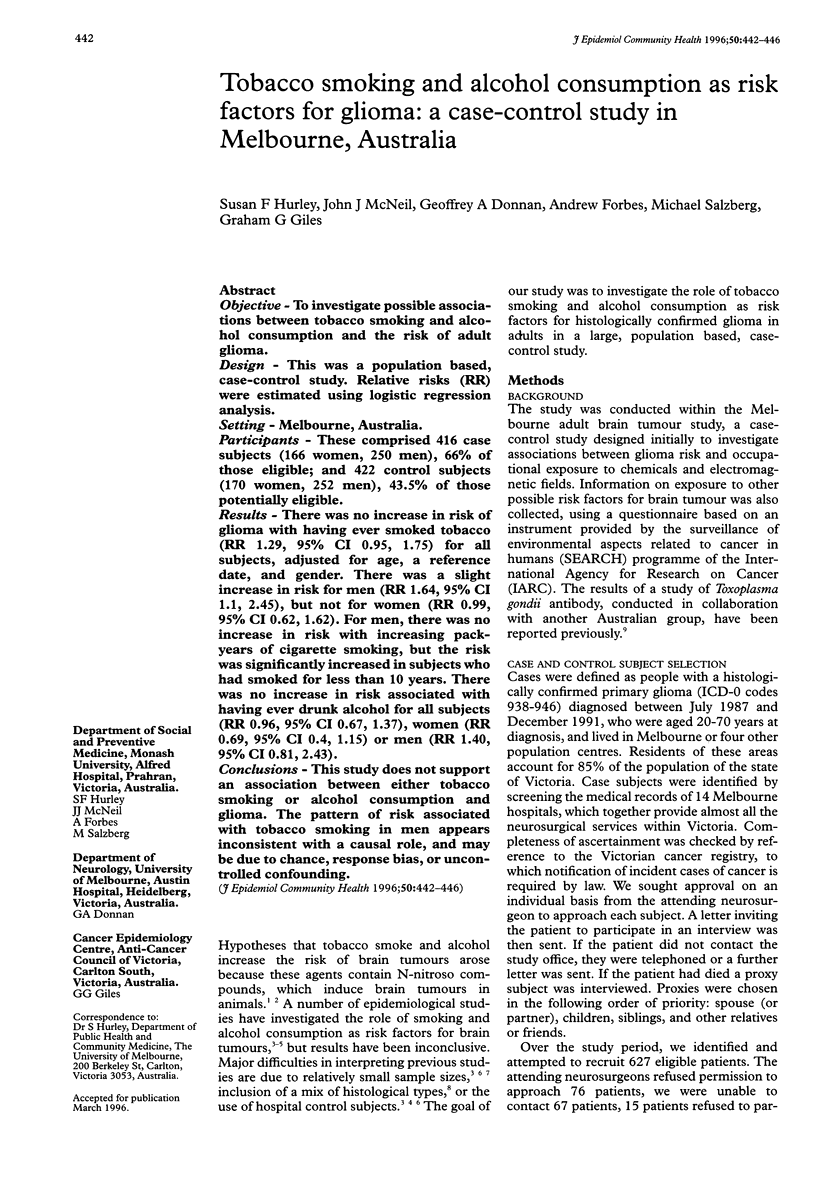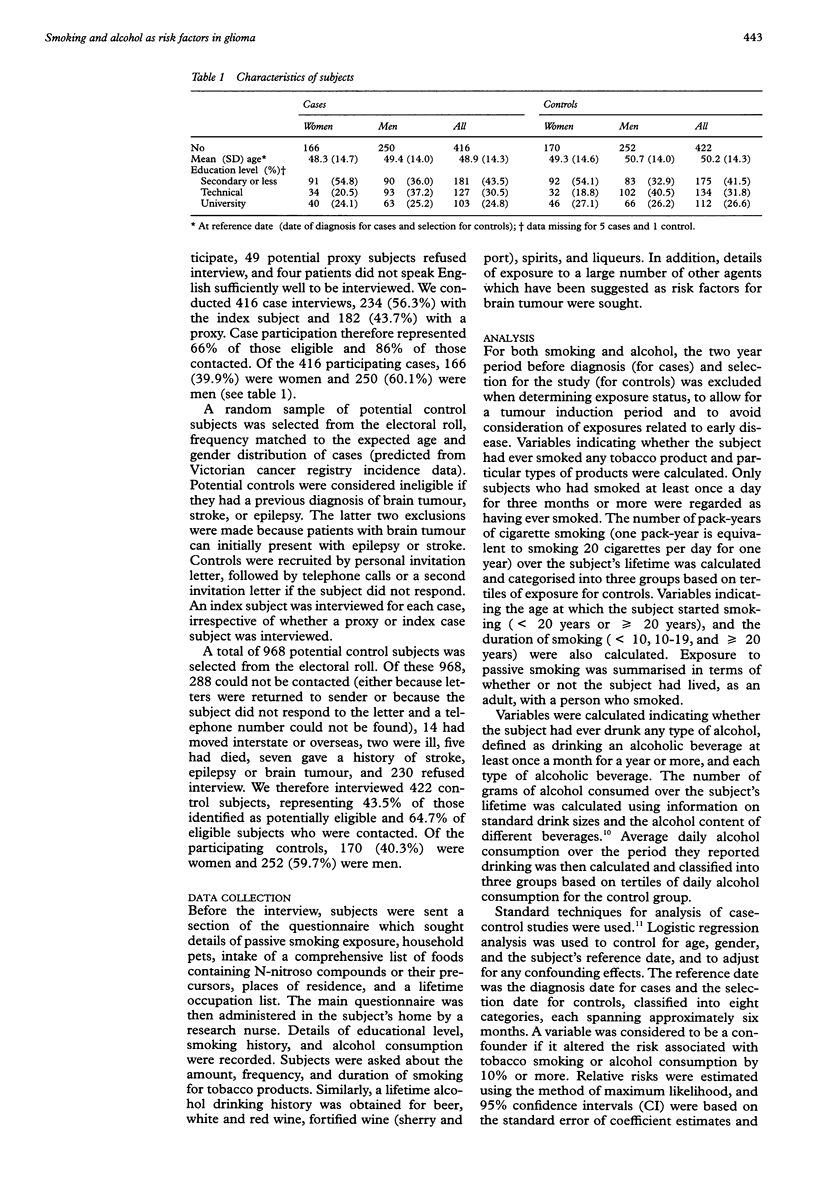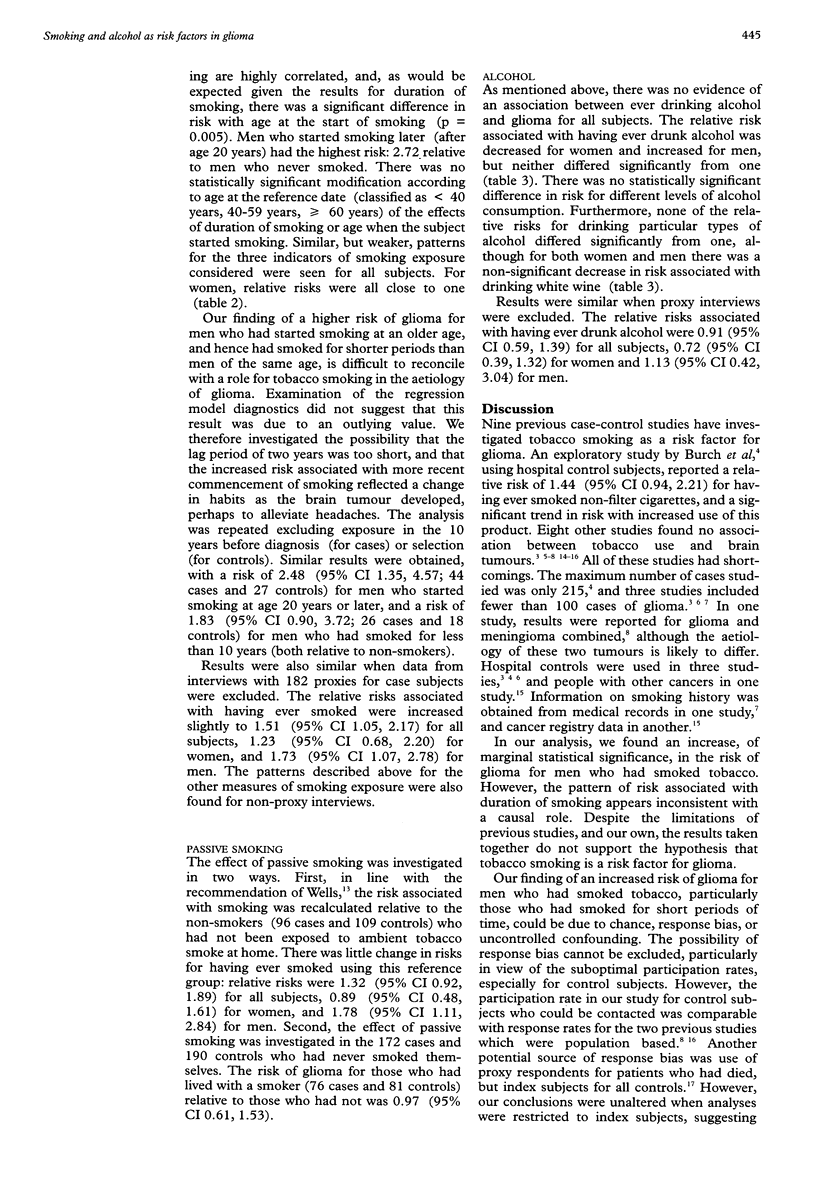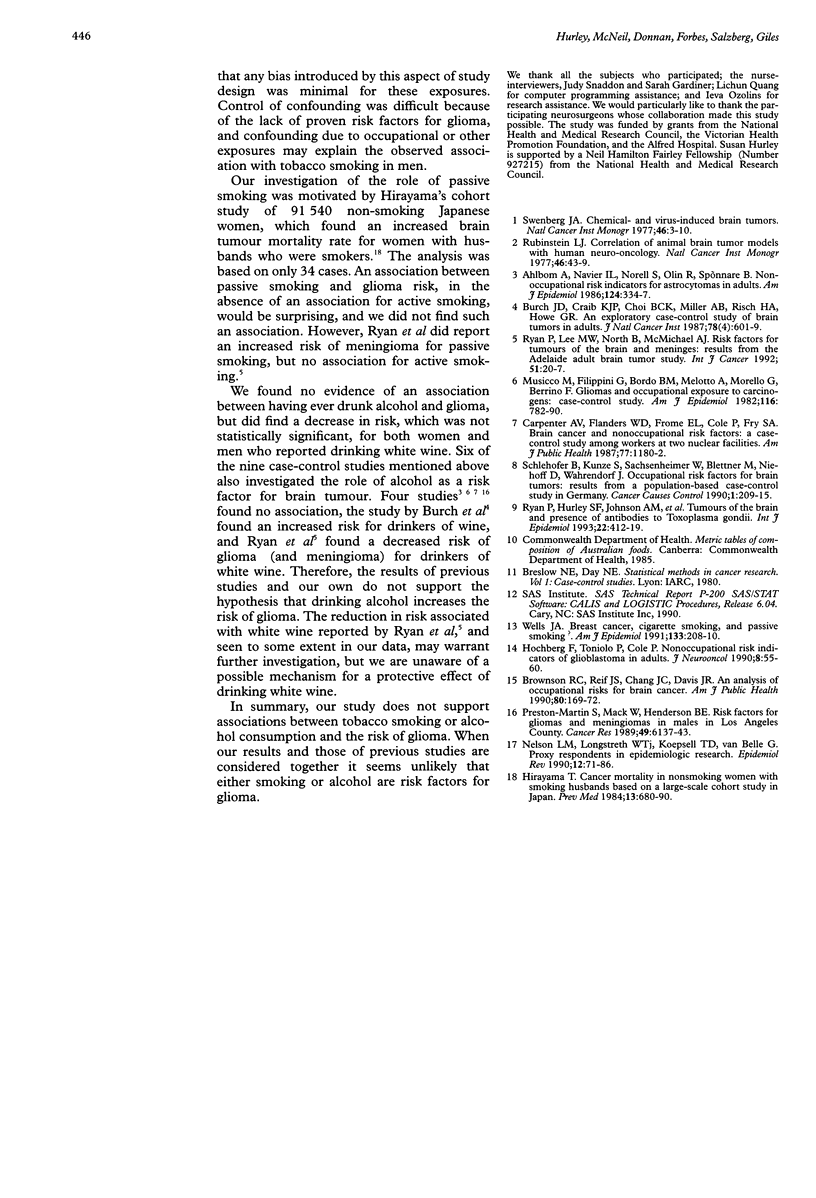Abstract
OBJECTIVE: To investigate possible associations between tobacco smoking and alcohol consumption and the risk of adult glioma. DESIGN: This was a population based, case-control study. Relative risks (RR) were estimated using logistic regression analysis. SETTING: Melbourne, Australia. PARTICIPANTS: These comprised 416 case subjects (166 women, 250 men), 66% of those eligible; and 422 control subjects (170 women, 252 men), 43.5% of those potentially eligible. RESULTS: There was no increase in risk of glioma with having ever smoked tobacco (RR 1.29, 95% CI 0.95, 1.75) for all subjects, adjusted for age, a reference date, and gender. There was a slight increase in risk for men (RR 1.64, 95% CI 1.1, 2.45), but not for women (RR 0.99, 95% CI 0.62, 1.62). For men, there was no increase in risk with increasing pack-years of cigarette smoking, but the risk was significantly increased in subjects who had smoked for less than 10 years. There was no increase in risk associated with having ever drunk alcohol for all subjects (RR 0.96, 95% CI 0.67, 1.37), women (RR 0.69, 95% CI 0.4, 1.15) or men (RR 1.40, 95% CI 0.81, 2.43). CONCLUSIONS: This study does not support an association between either tobacco smoking or alcohol consumption and glioma. The pattern of risk associated with tobacco smoking in men appears inconsistent with a causal role, and may be due to chance, response bias, or uncontrolled confounding.
Full text
PDF




Selected References
These references are in PubMed. This may not be the complete list of references from this article.
- Ahlbom A., Navier I. L., Norell S., Olin R., Spännare B. Nonoccupational risk indicators for astrocytomas in adults. Am J Epidemiol. 1986 Aug;124(2):334–337. doi: 10.1093/oxfordjournals.aje.a114393. [DOI] [PubMed] [Google Scholar]
- Brownson R. C., Reif J. S., Chang J. C., Davis J. R. An analysis of occupational risks for brain cancer. Am J Public Health. 1990 Feb;80(2):169–172. doi: 10.2105/ajph.80.2.169. [DOI] [PMC free article] [PubMed] [Google Scholar]
- Burch J. D., Craib K. J., Choi B. C., Miller A. B., Risch H. A., Howe G. R. An exploratory case-control study of brain tumors in adults. J Natl Cancer Inst. 1987 Apr;78(4):601–609. [PubMed] [Google Scholar]
- Carpenter A. V., Flanders W. D., Frome E. L., Cole P., Fry S. A. Brain cancer and nonoccupational risk factors: a case-control study among workers at two nuclear facilities. Am J Public Health. 1987 Sep;77(9):1180–1182. doi: 10.2105/ajph.77.9.1180. [DOI] [PMC free article] [PubMed] [Google Scholar]
- Hirayama T. Cancer mortality in nonsmoking women with smoking husbands based on a large-scale cohort study in Japan. Prev Med. 1984 Nov;13(6):680–690. doi: 10.1016/s0091-7435(84)80017-1. [DOI] [PubMed] [Google Scholar]
- Hochberg F., Toniolo P., Cole P., Salcman M. Nonoccupational risk indicators of glioblastoma in adults. J Neurooncol. 1990 Feb;8(1):55–60. doi: 10.1007/BF00182087. [DOI] [PubMed] [Google Scholar]
- Musicco M., Filippini G., Bordo B. M., Melotto A., Morello G., Berrino F. Gliomas and occupational exposure to carcinogens: case-control study. Am J Epidemiol. 1982 Nov;116(5):782–790. doi: 10.1093/oxfordjournals.aje.a113468. [DOI] [PubMed] [Google Scholar]
- Nelson L. M., Longstreth W. T., Jr, Koepsell T. D., van Belle G. Proxy respondents in epidemiologic research. Epidemiol Rev. 1990;12:71–86. doi: 10.1093/oxfordjournals.epirev.a036063. [DOI] [PubMed] [Google Scholar]
- Preston-Martin S., Mack W., Henderson B. E. Risk factors for gliomas and meningiomas in males in Los Angeles County. Cancer Res. 1989 Nov 1;49(21):6137–6143. [PubMed] [Google Scholar]
- Rubinstein L. J. Correlation of animal brain tumor models with human neuro-oncology. Natl Cancer Inst Monogr. 1977 Dec;46:43–49. [PubMed] [Google Scholar]
- Ryan P., Hurley S. F., Johnson A. M., Salzberg M., Lee M. W., North J. B., McNeil J. J., McMichael A. J. Tumours of the brain and presence of antibodies to Toxoplasma gondii. Int J Epidemiol. 1993 Jun;22(3):412–419. doi: 10.1093/ije/22.3.412. [DOI] [PubMed] [Google Scholar]
- Ryan P., Lee M. W., North B., McMichael A. J. Risk factors for tumors of the brain and meninges: results from the Adelaide Adult Brain Tumor Study. Int J Cancer. 1992 Apr 22;51(1):20–27. doi: 10.1002/ijc.2910510105. [DOI] [PubMed] [Google Scholar]
- Schlehofer B., Kunze S., Sachsenheimer W., Blettner M., Niehoff D., Wahrendorf J. Occupational risk factors for brain tumors: results from a population-based case-control study in Germany. Cancer Causes Control. 1990 Nov;1(3):209–215. doi: 10.1007/BF00117472. [DOI] [PubMed] [Google Scholar]
- Swenberg J. A. Chemical- and virus-induced brain tumors. Natl Cancer Inst Monogr. 1977 Dec;46:3–10. [PubMed] [Google Scholar]


